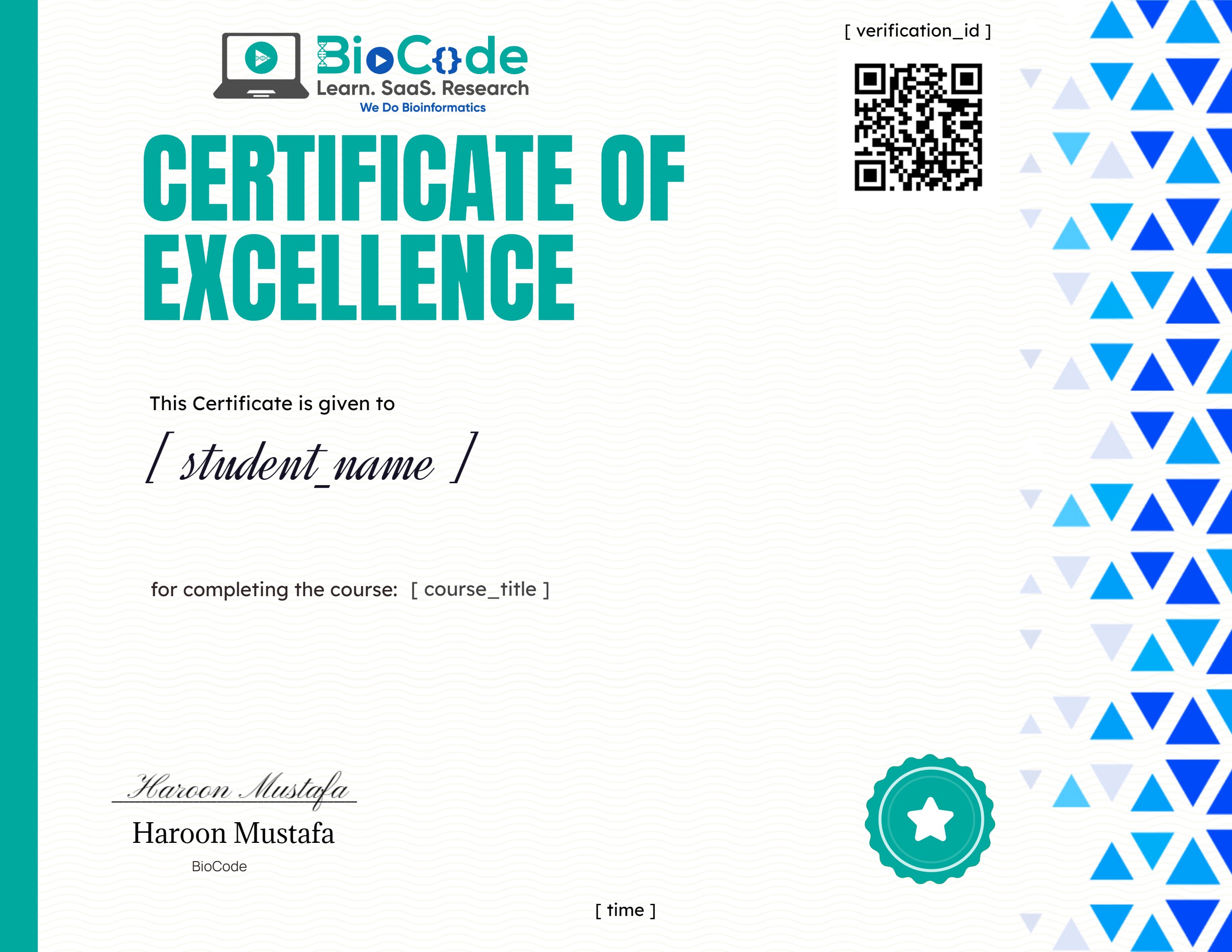Extensive Bioinformatician Course
About Course
Extensive Bioinformatician Course Allows You To Level-up Your Bioinformatician Skills From Basic To Intermediate Level
The major part of Bioinformatics revolves around analyzing biological datasets computationally, which often requires writing short scripts or patches of code to computationally analyze the biological datasets, rather than comparing and analyzing such huge datasets manually.
Being a Bioinformatician, one must learn how to retrieve and analyze biological data in the most efficient way, to learn how to align & analyze biological sequences to predict the evolutionary histories between them, to find out the conserved patterns, to learn how to predict coding regions or genes from a raw nucleotide sequence, and much more.
A bioinformatician must develop the skills to predict a good 3D structure of biological macromolecules, especially proteins, to predict the functionalities of newly discovered proteins, as well as, to to predict the molecular interactions for generating virtual simulations according to their molecular interactional information of a chemical/biological ligand & the receptor, which aids in the identification of lead compound in drug discovery & development.
In this course you’ll be able to level-up your Bioinformatician skills. Along with the most commonly utilized biological databases, how to find conserved patterns and variable regions within sequence alignments & analysis and perform phylogenetic analysis to find out the evolutionarily related species/sequences, you’ll also be able to predict, visualize and evaluate 3D structures of proteins and to predict molecular interactions between chemical/biological ligands & the receptor molecules, you’ll also be able to evaluate the conformations of the docked complex.
You’ll also be able to level-up your Biological programming skills in Python, BioPython & R. Along with the basics of biological programming in Python & R languages, you’ll learn how to read/write Bioinformatics files, work with various modules and built-in functions of BioPython for biological data retrieval, analysis and more.
Joining and learning from the Extensive Bioinformatician Course can enhance your biological career by learning through various useful & informative pre-recorded lectures on Bioinformatics tools, databases, servers and biological programming in Python.

Course Content
Bioinformatics Databases
-
Introduction to National Center of Biotechnology Information (NCBI)
18:02 -
Sequence Analysis
17:59 -
Sequence Retrieval from NCBI
16:17 -
PubMed Central & ENTREZ
11:07 -
GenBank: Nucleotide Database on NCBI
06:50 -
FASTA vs GenBank
18:26 -
Gene Database: A Comprehensive Gene Database
30:21 -
NCBI Genomes & NCBI Assembly: Retrieval of Genomes
36:14 -
RefSeq Database: Retrieval of Single Reference Sequences
11:16 -
BLAST Database Searching
25:37 -
Introduction to Molecular Modeling Database
08:07 -
Database of Short Genetic Variations (dbSNP)
12:16 -
HomoloGene: Discovery of Gene and Protein Families
06:11 -
Taxonomy
09:57 -
Introduction to UCSC Genome Browser & SARSCoV-2 Viral Genome
13:40 -
Retrieve an Entire Genome & Retrieval of SARS-CoV-2 Viral Genome
09:41 -
Table Browser & SARS-CoV-2 Viral Genome
12:16 -
Retrieval of Genomic Data & Annotation of SARS-CoV-2 Viral Genome
05:30 -
Visualization of Genomic Data on the Genome Browser & SARS-CoV-2 Genome
10:51 -
UniProt BLAST – Database Searching
12:33 -
UniProt Peptide Search – Find Regions Within UniProt Database
03:15 -
Introduction to ENSEMBL
07:50 -
Retrieval of a Gene-Protein-Chromosomal Region
18:02 -
Genome Assembly Retrieval and Analysis
10:24 -
Gene Analysis & Annotation
34:40 -
Variation Analysis
24:37 -
ENSEMBL BLAST/BLAT
15:08 -
Regulation – Understand the Influence of Regulatory Elements on Genes
04:19 -
Comparative Genomics Analysis
05:35 -
Introduction to Phytozome
09:39 -
Interpret Plant Genome Records
09:07 -
Download an Entire Plant Genome & Proteome
26:41 -
Keyword or BLAST Search in a Plant Genome
15:58 -
Visualize a Plant Genome Using JBrowse
17:38 -
UniProt Align – Pairwise & Multiple Sequence Alignment and Annotation
03:48 -
UniRef And Retrieve Protein Clusters
11:36 -
UniParc And Find the Non-Redundant Entries
04:59 -
Genome Reference Consortium (GRC)
07:48 -
BioProject
06:40 -
BioSystems
04:16 -
BioSample
02:56 -
Sequence Read Archive (SRA)
07:15 -
Gene Expression Omnibus – Platforms
05:42 -
Introduction to Gene Expression Omnibus Database
09:16 -
Gene Expression Omnibus – Samples
04:16 -
Gene Expression Omnibus – Series
04:01 -
Gene Expression Omnibus – Datasets
04:45
Bioinformatics File Formats
Protein Databases & Analysis
Sequence Alignment & Analysis
Phylogenetic Analysis
Secondary Structure Prediction
3D Structure Prediction
3D Structure Visualization
3D Structure Evaluation
Molecular Docking
Docking Complex Evaluation
Gene Prediction
PPI Database
Genomics Tools
Python
BioPython
R
Earn a certificate
Add this certificate to your resume to demonstrate your skills & increase your chances of getting noticed.

Student Ratings & Reviews


